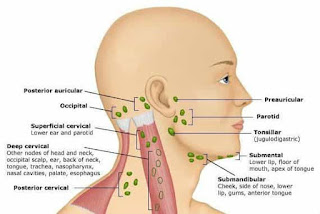They behave like mechanical filters. The job of these mechanical filters is to kill and eliminate microbes present in the blood stream. The white blood cells (WBCs) or lymphocytes are produced by the lymph nodes. On the other hand, WBCs kill bacteria and viruses entering the body.
Lymph nodes are very small organs, measuring only about 1-2 cm in size. They form a network throughout the body. There are about 500 lymph nodes spread across various organs of the human body.
A lymph node gets its particular name from its location and relation with the body organs. For example, the cervical lymph nodes are present in the neck or cervical region of the body. They protect the tonsils and the pharynx. Here you should note that swollen cervical lymph nodes is an indication of the lymphatic system disease.
 Lymph nodes in armpit are the axillary lymph nodes. Their job is to drain the chest region. You will find the mediastinal nodes near the sternum and the lung sacs. Meanwhile, for the drainage of the abdominal organs, there are the mesentery nodes.
Lymph nodes in armpit are the axillary lymph nodes. Their job is to drain the chest region. You will find the mediastinal nodes near the sternum and the lung sacs. Meanwhile, for the drainage of the abdominal organs, there are the mesentery nodes.Lymphatic System a Sewerage System: It won’t be wrong to compare the lymphatic system to a sewerage system. It has a networks of pipes to drain waste from every single body cell. The pipes in this system are defined as lymph vessels. The job of these vessels is to transport clear interstitial body fluid, that is, the lymph.
The Function of Lymph: The lymph is a watery fluid that flows in the lymphatic vessels. Its function is to help in effective draining mechanism.
Coordination of Drainage Mechanism: It is the muscles movements that coordinate the entire mechanism of draining. It is particularly because the lymphatic system has no specific pumping organs.
Bulging of Lymph Nodes: The lymph nodes bulge out in the presence of an infection. It is because, in case of an infection, they have to work hard to get rid of it.
Complementary Organs of Lymph Nodes: There are many organs in your body which protect the lymph nodes. They include spleen, tonsils, thymus and the adenoids. In addition to playing a protective role, these orangs are also complementary to the lymph nodes to form the immune system of body.
Lymphatic Circulation: About 2 liters of lymph fluid circulate in the body every day. During circulation, the lymph collects, destroys and eliminates foreign agents. Meantime, it also deals with the disease causing microbes.
Types of Lymphocytes: There are two types of lymphocytes or white blood cells that the lymph nodes produce. These are the B & T lymphocytes. The B-lymphocytes target bacteria and some viruses. Whereas the T-cells attack viruses in your body.

No comments:
Post a Comment